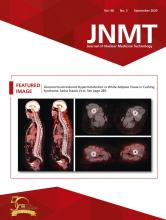Abstract
The purpose of this study was to evaluate the effect that the presence of a student in the PET/CT department has on the technologist’s occupational radiation exposure and whether this effect is influenced by the type of supervision performed. Methods: This was a retrospective, institutional review board–approved study that collected data from 2 PET/CT departments. Dosimetry reports, correlated with the clinical schedules of the students, were normalized for workflow (amount of radioactivity), the number of technologists, and the number of monitored days in the department. A 2-sample t test assuming unequal variance with an α of 0.05 was used to compare doses between with-student and without-student groups and between direct-supervision and indirect-supervision groups. Results: The study consisted of a dataset of 42 dosimetry reports, 19 with students and 23 without students. When comparing with-student and without-student groups, the total (n = 42) extremity dose had a P value of 0.012 with a mean of 0.0011665 μSv/MBq/technologist/d; all other dose comparisons between groups were greater than 0.05 (P > 0.05). For indirect supervision (n = 21), the extremity-dose P value was 0.298. The other dose P values were all less than 0.05. For direct supervision (n = 21), the dose P values were all greater than 0.05. There was a trend toward decreasing exposure of technologists when students were in the department. Conclusion: Extremity dose decreases when students are present. There is a trend toward decreasing dose with indirect supervision.
Footnotes
Published online Apr. 20, 2020.







